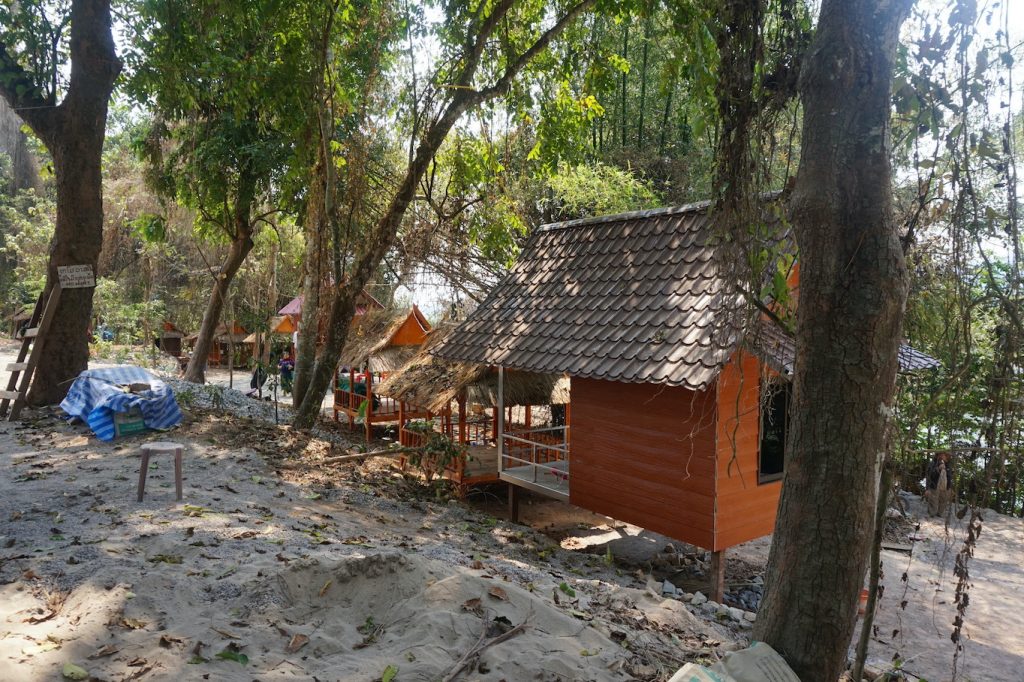 FISHBIO has developed a relationship with the Lao village of Sakai along the Mekong River over the last eight years, and during that time we have witnessed an evolution in fisheries management and conservation in the community. This village of some 970 people is located about 50 km west of the Lao capital of Vientiane. Most of the community members are farmers, but about 30 people engage in part-time fishing in the Mekong River to supplement their food and income. The sandbars in the middle of the river between Laos and Thailand are known to be a breeding site for the critically endangered Jullien’s Golden Carp (Probarbus jullieni). Now, the village has a community forest alongside a community-managed Fish Conservation Zone that serve as an attraction for local visitors who wish to connect with nature.
FISHBIO has developed a relationship with the Lao village of Sakai along the Mekong River over the last eight years, and during that time we have witnessed an evolution in fisheries management and conservation in the community. This village of some 970 people is located about 50 km west of the Lao capital of Vientiane. Most of the community members are farmers, but about 30 people engage in part-time fishing in the Mekong River to supplement their food and income. The sandbars in the middle of the river between Laos and Thailand are known to be a breeding site for the critically endangered Jullien’s Golden Carp (Probarbus jullieni). Now, the village has a community forest alongside a community-managed Fish Conservation Zone that serve as an attraction for local visitors who wish to connect with nature.
We first worked with fishers from Sakai to document their fishing catch through a participatory data collection project in 2013 and 2014 supported by the Mohammed Bin Zayed Species Conservation Fund. During our discussions with the community, they expressed interest in setting up more organized fisheries management to address challenges of illegal electrofishing in the area. After receiving a grant form the Critical Ecosystem Partnership Fund (CEPF), FISHBIO came back to work with the community from 2017-2020 to set up two Fish Conservation Zones (FCZs), or community managed freshwater protected areas. One 7-hectare FCZ is located near the Probarbus spawning site, and a second 67-hectare FCZ protects a section of the river alongside the village where deep pools are located. These protected areas prohibit all fishing and are regularly patrolled by the community.

Throughout the process of setting up their FCZs, the community of Sakai also moved forward with developing their community forest into a meditation site for Buddhist monks and other visitors. The 11-acre riverside stand of mature trees managed by the community is a rare sight this close to the county’s capital, where development is moving ahead quickly. The community built several meditation huts nestled in the trees along the river, recognizing that this retreat in nature offered a place for people to visit and improve their mental health. They currently receive about 30 visitors a month who come to visit the village’s Buddhist temple and community forest. There is no charge for admission, but donations are accepted to support the temple.

As part of this project, FISHBIO worked with two ecotourism and marketing consultants from Costa Rica who held virtual meetings with the community of Sakai to learn about their needs and interests in engaging visitors with FCZs. Based on the information collected, the consultants provided broad recommendations to enhance visitor experiences around the FCZs. This included a process based on “design thinking” to guide the development of FCZ conservation marketing products through the steps of 1) reflecting on the perspective of visitors, 2) defining visitor needs, 3) coming up with ideas for solutions, 4) creating prototypes, and 5) testing them out with visitors. Some specific recommendations on ways to use this method included the development of nature trails and signs about the Fish Conservation Zone and the village to help connect people to a sense of place.

As part of the project, we also helped the community of Sakai to install lights along the shore to assist with patrolling their FCZ at night, and are working with them to construct statues of Probarbus jullieni to help visitors connect with this unique endangered fish that lives in the river nearby. The FCZ has experienced some challenges, such as dropping water levels in the river that sometimes leave the habitat exposed. Illegal fishing also continues to be a widespread issue in the region. However, the village of Sakai has demonstrated a commitment to protect their natural resources for future generations, and to give visitors to their community ways to connect with the beauty and peace of nature.
